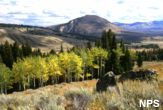Gene Maps Could Save Trees

A team of scientists has mapped the key genes in a group of trees that includes poplars and aspens, a result that could enable scientific rescues of all kinds of trees from drought and pests.
The group, called Populus, includes about 35 tree species worldwide and ten in North America. It is the most commonly studied tree by forest researchers because findings using Populus often hold true for other trees.
Stafan Jannsen of Umea University in Sweden led the computational part of the project to assemble the genomic map, or database. He says a complete map of all poplar genes will be released in the next week or two.
"Both the upcoming genome sequence and this database are tools that will make tree research more efficient in the same way that the corresponding resources for humans have revolutionized medical and pharmaceutical research," he said, referring to the sequencing of the human genome completed in recent years.
Jansson and his colleagues recently published a paper in the Proceedings of the National Academy of Sciences on the new genomic map.
In the paper, the team described trees as "a life form of paramount importance" for ecosystems and society because of their vast numbers and the huge amount of energy and industrial materials they supply.
The analysis showed a close similarity between the most frequently turned on or expressed genes in Populus and Arabidopsis, a mustard weed, with a fully sequenced genome, which is the most commonly studied plant.
Sign up for the Live Science daily newsletter now
Get the world’s most fascinating discoveries delivered straight to your inbox.
The ability now with these two genomic libraries to compare trees and plants will greatly speed genetic research on trees, said Steven Strauss, a forest scientist at Oregon State University, who also was part of the team.
Strauss called the public release of the database, accessible at www.populus.db.umu.se, a "landmark" achievement.
"This is an important fundamental step toward doing the type of genetic and biotechnology research with trees that we've been able to do with only the most scientifically well-known plants," Strauss said.
"There is no shortage of questions about ecological genetics that we can address" once the full Populus genome is released, he said.
Along with the mountain-dwelling aspens and poplars, this group of trees includes cottonwoods, commonly found along riverbanks. Autumn visitors to the Yellowstone National Park area are familiar with trembling aspen leaves, which turn a brilliant yellow.
The wood of this sun-loving group of trees is too soft for lumber, but the pulp is useful in paper-making and as a fuel source. Also these trees provide a critical habitat for many animals.
Biologists like working with Populus because the trees in this group grow fast and their cells are easy to clone for research purposes. They are often among the first trees to sprout up after a fire or other environmental devastation.
The new Populus database describes about 120,000 genetic sequences responsible for such functions as bark, leaf, root, and wood formation and responses to environmental stresses.
Scientists can use the database to quickly find specific genes in a matter of minutes using computers. In the past, such discoveries would have taken decades, Strauss said.
Then they can do research on how plants and trees respond to genetic modifications such as gene transfers and learn more about plant and tree biology, such as how and why plants age.
"Once you know a lot of gene sequences and can study thousands of genes at a time, you can start to really explore how trees might respond on a basic genetic level to such stresses as drought, exposure to cold, and pest attack," he said.
Some other top questions in forestry that the new database will aid in answering include which genes control the diversity of trees found in a forest, the ability of trees to adapt to their environment, and trees' overall health and productivity.
Down the line, the structure and chemistry of trees could even be genetically altered to eliminate pollutants from soil, Strauss said.
Robin Lloyd was a senior editor at Space.com and Live Science from 2007 to 2009. She holds a B.A. degree in sociology from Smith College and a Ph.D. and M.A. degree in sociology from the University of California at Santa Barbara. She is currently a freelance science writer based in New York City and a contributing editor at Scientific American, as well as an adjunct professor at New York University's Science, Health and Environmental Reporting Program.











